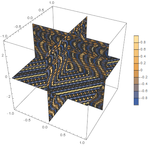SOCR News CMStatistics2022
Contents
[hide]SOCR News & Events: Quantum Mechanics Uncertainty, Data Science Inference, and AI in Complex Time (Kime)
Presenters
- Dr. Dinov is a professor of Health Behavior and Biological Sciences and Computational Medicine and Bioinformatics at the University of Michigan. He is a member of the Michigan Center for Applied and Interdisciplinary Mathematics (MCAIM) and a core member of the University of Michigan Comprehensive Cancer Center. Dr. Dinov serves as Director of the Statistics Online Computational Resource, Co-Director of the multi-institutional Probability Distributome Project, and Associate Director of the Michigan Institute for Data Science (MIDAS). He is a member of the American Statistical Association (ASA), International Association for Statistical Education (IASE), American Mathematical Society (AMS), American Association for the Advancement of Science (AAAS), American Physical Society (APS), and an Elected Member of the International Statistical Institute (ISI).
Session Logistics
- Session/Slot F: Saturday, 17 December 2022, 18:05 - 19:20 GMT (13:05-14:20 US ET)
- Date/Time: King's College London, 17-19 December 2022, GMT time-zone
- Talk Title: Quantum Mechanics Uncertainty, Data Science Inference, and AI in Complex Time (Kime)
- Registration: Registration Link
- Conference: CMStatistics 2022 meeting website
- Session: EO420: Advances in statistical neuroimaging and spatio-temporal modeling
- Zoom: ZM link
- Talk Format: Hybrid (In-Person & Online) Presentation.
Abstract
- By using complex time (kime) to lift the classical 4D space-time into the 5D space-kime manifold, this talk will demonstrate translating quantum mechanics principles to address data science and predictive analytics challenges. We extend the physical laws of velocity, momentum, Lorentz transformations, and 4D solutions of Einstein’s equations to their corresponding counterparts in 5D spacekime. Direct AI applications include transforming classical random sampling in spacetime to spacekime phase-uncertainty and a Bayesian formulation of spacekime analytics. Using neuroimaging and macroeconomics data, we will show examples mapping longitudinal data (e.g., time-series) to 2D manifolds (e.g., kime-surfaces) and discuss the subsequent modeling, inference, and AI based on space-kime representations.
Background
- SOCR News & Events
- SOCR Global Users
- SOCR Navigators
- SOCR Datasets and Challenging Case-studies
- Electronic Textbooks:
References
- Dinov, ID and Velev, MV (2021) Data Science: Time Complexity, Inferential Uncertainty, and Spacekime Analytics, De Gruyter (STEM Series), Berlin/Boston, ISBN 9783110697803 / 3110697807, DOI 10.1515/9783110697827.
- Wang, Y, Shen Y, Deng, D, Dinov, ID. (2022) Determinism, Well-posedness, and Applications of the Ultrahyperbolic Wave Equation in Spacekime, Journal of Partial Differential Equations in Applied Mathematics, DOI: 10.1016/j.padiff.2022.100280, in press.
- Zhang, R, Zhang, Y, Liu, Y, Guo, Y, Shen, Y, Deng, D, Qiu, Y, Dinov, ID. (2022) Kimesurface Representation and Tensor Linear Modeling of Longitudinal Data, Neural Computing and Applications Journal, DOI: 10.1007/s00521-021-06789-8.
- Spacekime website
- Time-Complexity and Inferential Uncertainty (TCIU)
Translate this page:
